

A pre-requisite for Road Network Operations is the collection of accurate data that defines the status of road network, the traffic conditions that prevail and information about roadway conditions and the immediate environment. (See Planning Procedures) Data on traffic and weather conditions, incidents and other road and highway status alerts is used to provide intelligence for network operations activities, traffic control and information systems. This process of gathering data is called network monitoring, and can be undertaken by using a variety of means or a combination of them:
The extent and reliability of monitoring directly affects the amount of information available to plan operational activities and, in turn, the degree of management and control that is possible. It also determines the quality of information that is available to travellers and road users. (See Network Monitoring)
A number of steps are involved in the organisation of data processing and information supply. Together they form an information supply chain.
The first step is to acquire data about the status of the road network and the traffic using it, as well as other transport modes that connect with it. This data can come from a wide variety of sources including probe vehicles and roadway sensors such as inductive loops and microwave sensors, Closed Circuit TV (CCTV), webcams, video image processing, toll tag readers. It can be augmented with other information gathered from crowd sourcing and journalistic sources. Data mining techniques are applied to historical data to gain further insight into traffic operations and to provide predictive information on network conditions. (See Traffic & Status Monitoring)
Once the data is collected, the next step is to process it in ways that will yield useful information. This covers a number of basic functions:
The third step relates to the data analysis. This requires an appreciation of contextual relevance, processing of content to produce information according to user needs and preferences – including formatting the data for service. Data needs to cover the geographical area of interest and be checked for timeliness. Key issues are:
To provide predictive information, various time series analysis, data mining, mathematical modelling and Artificial Intelligence (AI) methods are used (See Data Aggregation and Analysis).
Various methods are used to disseminate the data that has been collected, processed and analysed. A variety of transmission media are available. For example, incident warnings and travel information is provided via many dissemination media, including data subscription services, travel news broadcasts, Highway Advisory Radio (HAR), roadside Variable Message Signs (VMS), internet websites and social media such as Facebook and Twitter. The security and integrity of transmission needs to be checked and maintained at all times. (See Traveller Services)
Information needs to be presented appropriately in response to user needs and the context of use. Good design of the user interface is essential. In traffic control centres, data may be displayed alongside CCTV camera images on a video wall or on-screen at operators’ work stations. Other stakeholders and the travelling public will use a range of devices to access information – such as desktop, laptop and tablet computers, mobile devices and smartphones, in-vehicle displays, public information points and kiosks. (See User Interfaces)
Issues may arise related to data ownership and intellectual property in respect to the use of public sector data versus commercial and proprietary data, information branding, value-capture, revenue and payment. (See Legal and Regulatory Issues)
An effective (and often extensive) traffic surveillance and monitoring system is a pre-requisite for any intelligent traffic control system to keep track of prevailing conditions across the network. A wide range of different sensors are installed in, on and above the roadway for this purpose and to obtain the necessary geographical and critical time coverage. They include inductive loops, non-intrusive traffic detection devices, video cameras and video image processing. Each technology has its own advantages and shortcomings – so the choice of sensor type for any ITS application will depend on what performs well in the prevailing environmental conditions, and its cost.
Traffic detectors (or vehicle presence detectors) are used in many ITS applications for – network monitoring, traffic control, speed measurement and automatic incident detection. Many different types of detection technologies are available. The following are typical technologies that have been developed to measure traffic data in specific locations and zones. (See Vehicle Detection)
Inductive loop detectors are currently the most widely used devices for vehicle detection, although microwave radar detection is also common. Their main uses are at intersections in conjunction with advanced signal traffic control systems, and on freeways for traffic monitoring and incident detection purposes. ILDs typically take the form of one or more turns of insulted wire embedded in the pavement. The loop is connected via lead-in cable to the detector unit, which detects changes in the loop inductance (changes in the in the magnetic field of the sensor) when a vehicle passes over it. ILDs can be used to detect a vehicle’s presence or passage. They can also be used to measure speed (by using two loops a short distance apart) and for classification of vehicle types. The main problem with using ILDs, however, is their reliability. Because ILDs are subject to the stress of traffic, they tend to fail quite frequently. Moreover, their installation and maintenance require lane closure and modifications to the pavement.
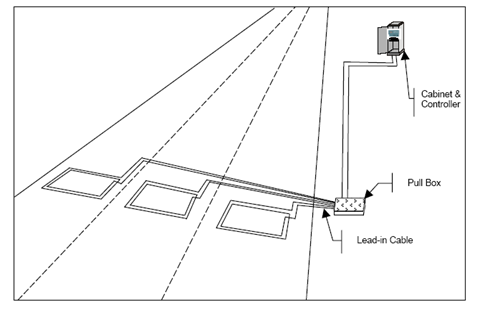
Inductive Loop Detectors
Microwave radar detectors are examples of non-intrusive detection devices whose installation and maintenance does NOT require lane closure and pavement modifications. Unlike inductive loops, non-intrusive detection devices are not embedded in the pavement. Instead, they are typically mounted on a structure over, or to the side of, the road such as the radar detection system in the photograph below. Depending on the type of electromagnetic wave used, microwave radar detectors can measure either vehicle presence, or vehicle presence as well as speed. They are also widely used to detect pedestrians waiting at pedestrian crossings.
One of the major advantages of microwave sensors is their ability to function under all weather conditions. Exceptions can be extreme weather such as sand-storms. Given that these sensors are installed above the pavement surface, they are not typically subject to the effects of ice and ploughing activities. Experience shows that microwave sensors function adequately under rain, fog, snow, windy conditions. Their main problem is that they can be obscured by tall sided vehicles – reducing their accuracy when they are installed at the side of the carriageway.
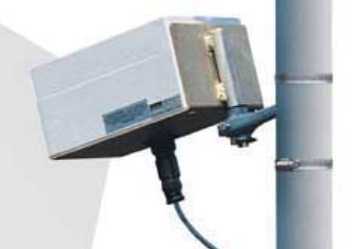
Non-intrusive Traffic Detector (Image courtesy of the IBI Group)
Infrared (IR) sensors are also non-intrusive detection devices. There are two types: passive and active detectors.
Passive IR detectors do not transmit energy – instead, they detect the energy that is emitted or reflected from vehicles, road surfaces and other objects. Passive infrared detectors can measure speed, vehicle length, vehicle counts and occupancy but their accuracy is affected by adverse weather conditions.
Active IR detectors emit a beam of Infrared energy which is reflected back to an IR receiver. They function in a similar way to microwave radar detectors – by directing a narrow beam of energy towards the road surface. The beam is then reflected back to the sensors – and vehicles are detected through changes in the “round-trip” transmission time of the infrared beam. Active infrared detectors supply vehicle passage, presence, speed, and vehicles classification information. They work well in controlled environments such as tunnels – and infrared can be used for safety purposes to detect over-heating vehicles or fire. Their accuracy is affected by weather conditions such as fog and precipitation.
Ultrasonic vehicle detectors function in a similar way to microwave detectors by actively transmitting pressure waves, at frequencies above the human audible range. These detectors can measure volume, occupancy, speed, and classification. Ultrasonic sensors are sensitive to environmental conditions. They require a high level of skill for their maintenance.
Vehicle traffic produces acoustic energy or audible sound from a variety of sources within the vehicle and from the interaction of the vehicle’s tyres with the road surface. Using a system of microphones, acoustic detectors are designed to pick-up these sounds from a specific area within a lane on a roadway. When a vehicle passes through the detection zone, a signal-processing algorithm detects an increase in sound energy and a vehicle presence signal is generated. When the vehicle leaves the detection zone, the sound energy decreases below the detection threshold and the vehicle presence signal ends. Acoustic sensors can be used to measure speed, volume, carriageway occupancy and presence. The advantage of acoustic sensors is that they can function under all lighting conditions and during adverse weather.
Similar to inductive loop detectors (ILD), magnetometers provide for point detection, but they differ from ILD in that they measure changes in the earth’s magnetic field resulting from the presence of vehicles. They can provide information on traffic volume, lane occupancy, speed as well as vehicle length. In general, there are two types of magnetometers:
Micro loops, (like inductive loops), require lane closure and pavement modification, with consequent delays to traffic. In recent years, the use of wireless magnetometers has received increased interest because of advances in battery technology which allow a unit to operate wirelessly for a period of 10 years before needing to be replaced.
Traffic Detector Video Training Course - Part 1 - Detector Theory
Traffic Detector Video Training Course - Part 2 - Detector Design
Traffic Detector Video Training Course - Part 3 - Detector Installation
Traffic Detector Video Training Course - Part 4 - Detector Maintenance
AVI can be used to identify vehicles as they pass through a detection zone. Typically, a transponder (or a tag) mounted on the vehicle can be read by a roadside reader as the vehicle passes by. This information can then be transmitted to a central computer. Currently, the most common road transport application of AVI technologies is in combination with Automatic Toll Collection systems (such as EZPass). With these systems, the value of the toll is automatically deducted from a driver’s account each time the driver goes through the toll plaza.
An important method of AVI, in common use, are ANPR (also known as Automatic Licence Plate Recognition - ALPR) systems which use optical character recognition technologies to identify and recognise vehicle registration plates. They typically consist of a specially adapted video camera linked to character recognition software. As a vehicle passes an ANPR/ALPR camera its registration number is read and can be checked against a database of vehicle records. There are two broad types of ANPR/ALPR systems:
With recent advances in computer hardware and software – processing in the field in real-time has become quite feasible (it typically takes less than 250 milliseconds). This avoids the cost associated with the need for large bandwidth to transfer images to a remote server.
Weigh-in-motion sensors are designed to measure and record axle weights and gross vehicle weights while the vehicle is in motion (driving – not stopped). WIM systems are attractive because they avoid the need to stop and weigh every vehicle. They have not eliminated the need for weighbridge sites for accurate weighing of trucks, but WIM acts as a filter and only vehicles which register an excess axle load need to be stopped and checked. The key component of any WIM system is the force sensor – for example quartz crystals produce electric charge when a force is applied along the vertical axis (the weight of the vehicle). WIM systems have several applications in ITS, especially as a part of an electronic pre-clearance system for commercial vehicles, as well as for enforcement applications. (See Enforcement and See Video)
Speed detection is an integral part of speed camera enforcement systems used to detect speed-related violations of traffic rules especially at accident hot spots. (See Speed Management) Regulation of speed is important at work zones where personnel are at increased risk of an accident. It is also a feature of active traffic management schemes on motorways. Some speed enforcement systems automatically link speed cameras to vehicle number-plate (Licence-plate) recognition for issuing enforcement notices. (See Traffic Management and Integrated Strategies) Speed detection can also be used as a safety measure at signalised intersections on fast arterial roads by using microprocessors to extend the green time at traffic signals when a vehicle is approaching at speed.
For measuring speed, the most common device is a radar meter or sensor which uses the Doppler principle. Specifically, the device measures the difference in the emitted and reflected frequency of a radar wave – which is proportional to the speed of the moving object. Other types of vehicle sensors can be adapted in pairs to measure speeds – such as ultrasonic sensors and magnetometers.
Journey time monitoring is related to speed monitoring. Vehicle journey times are significant sources of information for network performance monitoring and advising road users about travel delays in real-time. They are a measure of the level of service on offer. Some road authorities display point-to-point journey times on roadside VMS as a form of real-time information. Journey time data (historic and in real-time) is also a useful resource for journey planning and logistics support. (See Journey Time Monitoring)
Various methods are available to anonymously track vehicles on the network and enable network operators to determine average travel times, point-to-point demand and traffic flow conditions. For example, Automatic Toll Collection (ATC) systems can be used to determine the average travel time on highways between toll collection plazas or specially installed roadside readers. Infra-red (IR) tag-equipped vehicles are used as probes for monitoring traffic flow conditions – which are detected by transponder readers, installed along roadways. Aggregate data on average speeds and travel times can be compiled and this helps support incident and traffic management. To protect travellers’ privacy, these systems scramble the toll tag identifiers and only keep records of trips made by anonymous vehicles.
A number of other techniques are used to provide continuous, non-invasive, point-to-point tracking of individual vehicles to determine travel times and calculate average speeds. They include automatic number-plate recognition cameras (ANPR cameras) to identify vehicle licence plates. A new development is point-to-point monitoring of Bluetooth signatures emitted by equipment present in the vehicle. Bluetooth sensors have been used successfully for point-to-point average speed monitoring as a cheaper alternative to ANPR. Some road authorities use aggregated data (made anonymous) to display on VMS to provide drivers with expected journey times between key points on the network.
Environmental sensors are used in road network monitoring to detect adverse weather conditions such as icy or slippery conditions, high winds or precipitation (snow or rain) or the presence of fog/mist. This information can then be used by operators to alert drivers via variable message signs (VMS). It can also be used by highway maintenance personnel to optimise winter maintenance operations. (See Weather Monitoring)
Environmental sensors can be divided into six types:
Many manufacturers provide complete weather station systems that are capable of monitoring a wide range of environmental and surface conditions. The figure below shows one example of these weather stations.
(Figure 4.7 to be located here – to be supplied by the author)
Weather stations typically include the following types of sensors and capabilities:
Road condition sensors: A critical component of any road weather information system (or RWIS) is a set of road condition sensors that measure surface temperature and moisture, and detect the presence and thickness of snow and ice. Road condition sensors can be embedded in the pavements. They can also be non-intrusive – mounted to side or above the road surface. Non-intrusive road condition sensors typically measure the emitted infrared radiation from the road surface.
Visibility sensors: These sensors are designed to measure visibility along a road section. They typically use the principle of “forward scattering” or diffraction of light to detect changes in visibility resulting from inclement weather conditions such as fog, haze, and smoke. The sensors need to be carefully sited because they can only provide spot measures at a specific location. For example, fog detectors need to be sited as near as possible to the source where mist or fog forms first.
Thermal mapping: Given that temperatures can vary significantly along a roadway segment, thermal (temperature) mapping sensors are typically a critical component of an effective ice detection system. Thermal mapping provides road operators with information on road-surface temperatures to inform decision making on the need to set-up warning messages on VMS or to deploy snow clearance, road salting and gritting services. Examples of thermal imaging sensors include thermal imaging cameras/ video and infrared thermography.
Wind speed sensors: These are an essential component of an environmental sensing station and are installed at high and exposed bridges and windy locations on the road network. They typically measure surface wind speed and direction and can be used to provide warnings to vehicles towing trailers and high-sided vehicles. For safety reasons it is sometimes necessary to close the road in high winds.
Mobile reports can be divided into two categories:
In many cases, reports of incidents made by citizens and the police can provide significant road network monitoring information – and at a very low cost compared to other surveillance technologies. Mobile reports do not provide a continuous stream of condition data provided by other surveillance technologies, but they so provide event information at unpredictable intervals that are very useful for traffic management purposes. In particular, mobile reports are very effective for incident detection.
A number of different mobile reporting methods are used in road network operations.
Cell phones are a very effective tool for incident detection. Many regions have established an incident reporting hotline to encourage citizens to report traffic incidents. This has the advantage of low start-up costs.
The widespread use of cell phones can provide useful traffic information. Triangulation techniques can determine a vehicle’s position by measuring signals from an on-board cellular phone within the vehicle. To enable this, the cell phone needs to be communicating with more than one cell-phone cell – preferably three or more for accuracy – so that triangulation can take place. Each phone is typically identified by its electronic serial number. This concept was first tested in the Washington D.C. area in the mid 1990s. This concept is different from GPS-based AVI systems in which the GPS unit on the phone determines the location, which is then communicated from the phone to a central processing system.
Emergency Roadside Telephones (ERTs) were regularly provided prior to mobile telephones becoming widely available. ERTs still provide a valuable service where there is a low ownership of mobile telephones or a mobile-phone black spot. They provide an accurate location to the operator of where a caller is located and enable stranded motorists to call for help. More generally, they allow travellers to report incidents such as accidents or stray animals on the carriageway.
To use a call box, the motorist just needs to lift the receiver or press a key to request the services of the police or emergency services. The caller is automatically connected to a control room operator.
Advanced types of ERTs provide background noise cancellation against traffic noise, and a simple question and answer facility based around «yes» and «no» keys for the profoundly deaf and foreign travellers. The Operator has a formal list of questions that they can ask in sequence by typing in the questions. The questions appear on a small screen at the ERT and the user answers using the yes and no keys. The option to select different languages is a great advantage near ports and border crossings where there is a high percentage of foreign visitors. They also have a call-back facility that enables the operator to call the stranded motorist, with a beacon and ring tone to attract attention.
Typically, the phones are located on the side of the freeway, and are spaced at distances ranging from 0.25 miles to 0.50 miles apart. On all-purpose dual carriageway arterial roads, freeways and motorways they need to be located in pairs on either side of the road to avoid travellers being tempted to cross the road to use one.
(Figure 4.5 Call Box – Image to be provided by Barry Moore)
These are teams of trained officers who are responsible for covering a given segment of the freeway. Mobile patrols have a central part to play in road network operations, spotting debris on the road, dealing with incidents and the general public. A freeway service patrol vehicle [Figure 4.6] is typically equipped to be able to help stranded motorists and, where possible, to clear an incident site. Mobile patrols are capable not only of responding to incidents, but in some cases to perform the entire incident management process (from detection to clear-up).
Technology, in the form of secure mobile communications and hand-held tablets, provides support. TETRA mobile radio communications offer digital transmission capability whilst maintaining the advantages of a Private Mobile Radio (PMR) system. In future service patrols may have command and control capability to direct and manage the deployment of on-road resources – and the potential to set VMS and signals on location, remotely from the road side.
Figure 4.6 A Freeway Service Patrol Vehicle
A relatively new technique for collecting traffic-related information based on mobile reports is crowdsourcing – using social networks such as Facebook and Twitter. Crowdsourcing is the process of obtaining information online that is provided by a crowd of people. This method has become feasible in recent years because of the significant developments in positioning and communications technologies that are linked to mobile phones which have internet connectivity. In road transport, crowdsourcing concept can be used to collect vital travel-related information in collaboration with members of a community. One of the most famous and successful of these crowd-sourcing applications is WAZE (https://www.waze.com/) – one of the world's largest community-based traffic and navigation apps. Users of WAZE share real-time traffic information, allowing members of the on-line community to save time and fuel while travelling.
Vehicles are used to report journey times and detect traffic incidents – monitoring their progress in time and space. This can be done by either using automatic vehicle location systems or by tracking the progress of identified vehicles between known fixed points on the network. The location of the vehicle in time and space is communicated to a central computer where data from different sources is fused to determine the status of traffic flow over the transport system.
Vehicle probes can provide very useful information that other detection techniques cannot – including information on link travel times, average speeds, and origin-destination information.
Different technologies are available. These include:
Vehicle probe methods give more reliable but less dense data than crowd-sourcing, which may provide better geographical coverage. Vehicle probes are often deployed by road network operators in collaboration with the owners of vehicle fleets that regularly travel the network.
CCTV cameras play an important part in road network management. They are installed at sensitive locations on the network to support traffic management, where congestion and traffic queues are frequent and at other locations where there is an increased risk of accidents and traffic incidents. When used for traffic surveillance they can either have a fixed field of view – for example, when used to monitor traffic and provide alerts – or be equipped with a pan, tilt and zoom (PTZ) capability to allow operators to have a wider field of view.
Fixed field of view cameras are generally used for monitoring motorway sections where hard shoulder running is permitted.
Pan, Tilt Zoom (PTZ) cameras are commonly used for:
Either fixed or PTZ cameras can be used:
Control room operators depend on the CCTV camera images – displayed either on their work-stations or large-scale on a “video wall”. CCTV camera images are an important means of traffic surveillance that complements other traffic control measures. Operators rely on images from CCTV cameras to detect and monitor traffic incidents and assess the number of running lanes affected. From this it may be possible to estimate the likely duration of a traffic incident based on previous experience and traffic modelling techniques. Video image processing is used to alert control room operators to stationary vehicles and other unusual events. Operators often wish to see a sequence of images from successive CCTV cameras, in the form of a “video tour” (See Traffic Control).
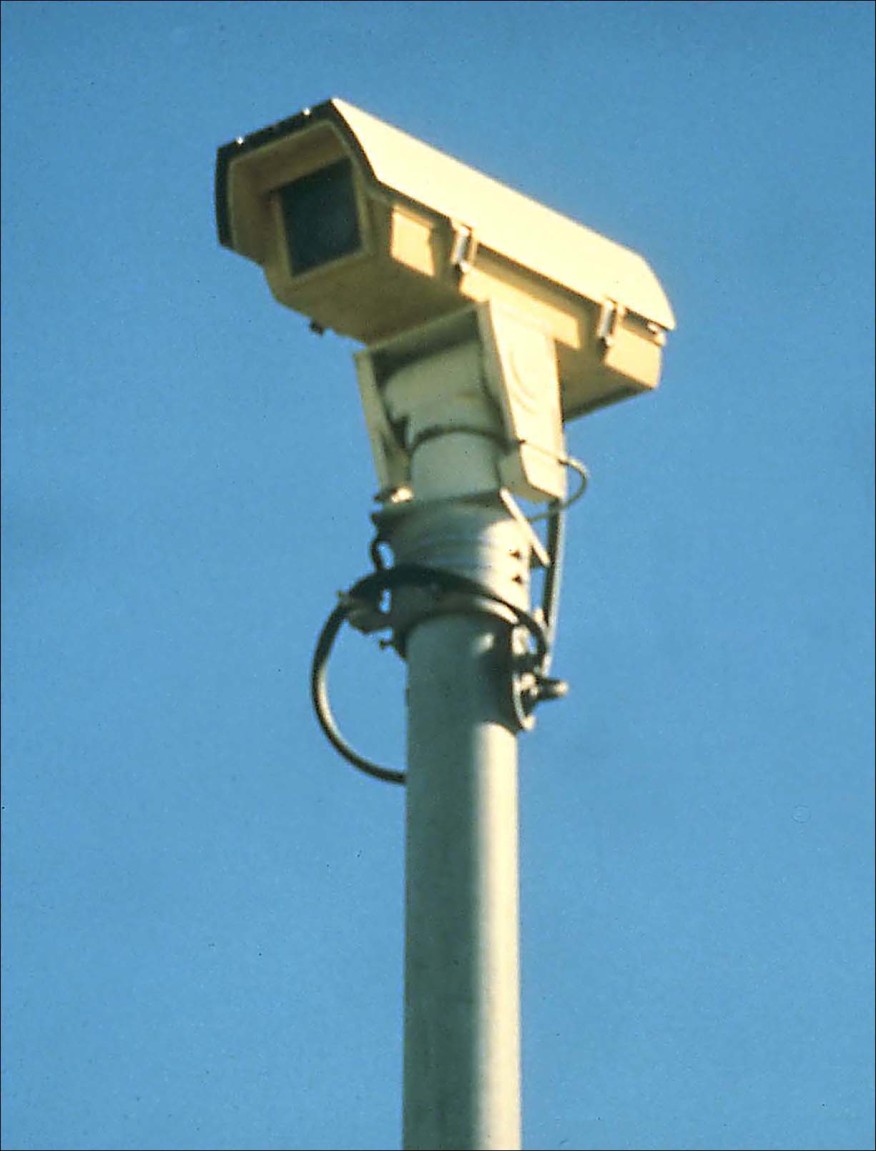
Pan, Tilt and Zoom (PTZ) Closed Circuit TV Camera (Image courtesy of the IBI Group)
Video image processing (VIP) identifies vehicles and their associated traffic flow parameters by analysing imagery supplied from CCTV cameras which normally have a fixed field of view. The addition of VIP significantly improves the usefulness of CCTV, particularly where there are a large number of cameras installed, which an operator cannot view at the same time. VIP also provides the means for alerting operators to a traffic incident.
Analogue CCTV images are digitised and then passed through a series of algorithms that identify changes in the image background. In modern digital cameras the video image is already in a digital form – ready for processing. A VIP system consists of a video camera (a digitiser in the case of analogue cameras) and a microprocessor for processing the digital-image – and software to interpret the image content and extract detection information from it.
With digital processing CCTV provides an above-ground alternative to inductive loops or other means of vehicle detection. One big advantage of VIP systems is their ability to provide detection over a number of lanes and in multiple zones within the lane – providing wide area detection. The user can easily modify the detection zones, within seconds, through the graphical interface – without the need to close traffic lanes and dig-up the pavement. Poor lighting, shadows, and bad weather can negatively affect the performance of VIP systems. Evaluation studies in Oakland County, Michigan indicate that modern VIP systems yield excellent performance with a detection accuracy of over 96% under all weather conditions.
VIP systems can be combined with CCTV systems to provide an excellent detection tool, particularly for incident detection and verification purposes. When an incident occurs, the user can switch from the VIP mode to the standard CCTV mode, and then verify the occurrence of the incident via pan/tilt/zoom controls.
An effective interface with users is an essential part of many ITS applications. Users include control centre operators, the police and emergency services, road users and travellers. Many technologies support the dissemination of pre-trip and en-route information. To make traveller information available, historical and current traffic data and status of the network needs to be monitored and processed and put in a format which travellers can easily access (See Travel Information Systems).
Pre-trip traffic information provides travellers with information before they start their journeys. Examples of pre-trip traveller information include information on current or expected traffic conditions, current and expected weather conditions, and information on public transport schedules and fares. It is intended to help travellers to make informed route/mode/time of departure decisions (See Pre-trip Information).
En-route traffic information provides travellers with information while they are travelling. En-route traffic information includes many of the same elements provided for pre-trip planning – but updated in real-time – such as information on current and expected traffic and weather conditions, information on incidents and suggested diversion routes.
ITS uses many traffic information dissemination platforms to keep people informed about current as well as expected travel conditions. These include Dynamic Message Signs (DMS), Highway Advisory Radio (HAR), cable TV, traveller information websites and the Internet, dedicated phone systems, cellular telephone applications – and in-vehicle display. Information dissemination devices can be classified as:
With the proliferation of portable and mobile computing devices – such as smart phones and tablets – this three-way distinction is less clear now than it used to be. These are capable of accessing the Internet while the traveller is en-route – and there may be concerns about driver distraction and regulations against their use in certain circumstances (See Human Factors).
Dynamic Message Signs are also referred to as Variable Message Signs and Changeable Message Signs. In this website the following terminology is used:
A DMS may be either a Variable Message Sign (VMS) or Changeable Message Signs (CMS) where:
DMS are among the most common types of devices for information provision. They can either be fixed or portable as shown below. They can be text-based, graphics based or a combination of the two (See Traffic Management)
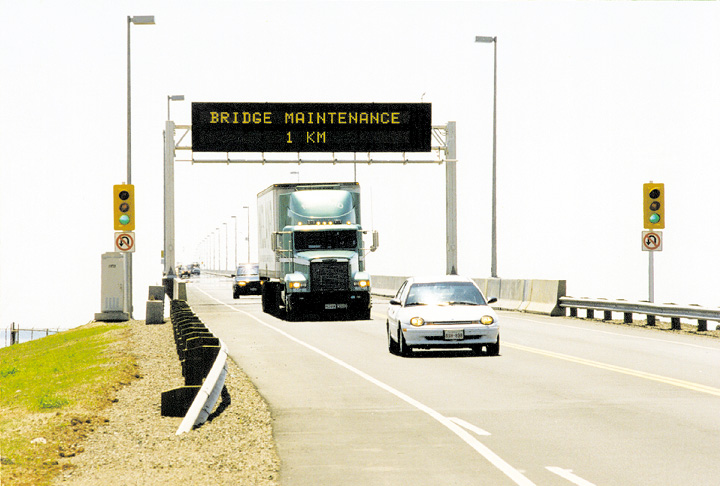
Figure 4.12 Fixed Dynamic Message Signs
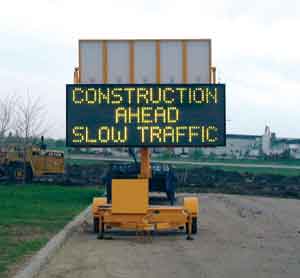
Figure 4.13 Portable Dynamic Message Signs
DMS can be used to provide travellers with instructions such as closed lanes or recommended speeds and information on traffic and weather conditions, incident locations and expected delays, construction work, alternative routes and speed advisories. Different types of DMS can be light-reflecting, light-emitting, and hybrid according to the technology used. Light emitting diodes (LEDs) are generally the preferred option where there is a power supply (including solar options).
As the name suggests, these rely on an external source of light, such as the sun, headlights, or overhead lighting, to make them visible – by reflecting the light source. Different types of light-reflecting signs include rotating drum and reflective disk matrix signs. Rotating plank/drum signs are made of one to four multi-faced drums, each containing two to six fixed text messages or graphics. The main application of rotating plank/drum technology when it is incorporated into a fixed direction sign – is to provide variable instructions, that are identical in appearance to the fixed sign face, to show an alternative direction to a destination.
Reflective disk matrix signs comprise an array of permanently magnetised, pivoted indicators that are black on one side, and reflective white or yellow on the other. When a specific pixel is activated, an electric current flips the indicator from the black finish to the reflective yellow finish.
Reflective disk matrix signs were popular in 1970s for freeway management systems because they were less costly than light-emitting signs. Mechanical failure of some or the entire message is common (disk failure). As LED signs become less costly the older technology is falling out of use.
These generate their own light on or behind the viewing surface – either in monochrome or full colour. Light emitting diode (LED) and fibre-optic DMS are two examples:
LED has become the preferred technology. New versions of LED DMS provide a display known as a full matrix that can display graphics and images.
Hybrid DMS combine the characteristics of both light-reflecting and light-emitting DMSs. One of the best examples of hybrid DMSs is the reflective disks/fibre-optic or LED DMS. During weather conditions when light-reflecting DMS are not clearly visible, these hybrid systems can use light-emitting technologies such as fibre-optics or LED. When the sun is shining, the light sources are turned off. Solid state LEDs are more reliable than reflective disks since there is no risk of mechanical failure.
In-road markers or lane lights (also known as intelligent road studs) can be used to convey important messages to drivers, in addition to their most direct function of lighting the way at night. For example, in-road markers can be used to communicate the usage of a lane. Intelligent road studs have been used for signing the use of the hard shoulder during periods of heavy congestion, hazard warnings and operation of part-time bus lanes
These devices are typically located inside the vehicle and, similar to DMS, are designed to provide information to drivers while en-route. In-vehicle information devices can provide information by either audio or visual means. Examples of auditory in-vehicle information devices include highway advisory radio (HAR), cellular phone hotlines and commercial radio. Examples of visual in-vehicle devices include video display devices and head-up displays (which drivers can read without altering their normal viewing position
Highway advisory radio (HAR) provides another means for disseminating information to drivers while en-route. Typically, information is provided through an AM receiver. Drivers are informed about the existence of an HAR signal by signs which are typically installed upstream of the signal, advising drivers to tune in to a specific frequency (typically either 530 kHz or 1610 kHz) (See Radio).
HAR can be used to provide travellers with information similar to that provided by VMS. One advantage of HAR compared to VMS is that it is less distracting – since information is provided through a different sensory channel (audio) which reduces visual information overload. More complex messages are also possible with HAR compared to DMS. The disadvantage is that users have to tune to the frequency themselves.
Another way of providing information to drivers en-route, – which has increased in popularity with the widespread use of cellular phones – involves establishing a “hotline” phone system for traffic information that drivers can call from their cell phones while en-route (such as the 511 system in the US). The phone systems typically include a touch-tone menu that allows callers to receive route-specific traffic information – this gives the driver control over the type of information received.
Commercial radio is another means of providing en-route traveller information. The primary disadvantage of commercial radio is the accuracy and timeliness of the information. Typically, information is broadcast only when normal scheduling permits – and in many cases, this may be inappropriate since an incident might have been cleared by the time normal scheduling permits broadcasting.
A recent approach to disseminating traffic information en-route involves the use of dashboard displays, video and head-up display terminals. Close attention to the design of the Human-Machine Interface is needed to minimise driver distraction (See Human Factors).
These technologies are widely used for pre-trip and off-roadway information dissemination. They include cable TV, phone systems, the internet, pagers, smart phones and tablet computers. Many metropolitan areas around the globe now have websites dedicated to traveller information. These systems provide travellers with a wealth of travel-related information, including current travel conditions, alerts, and other timely information. A traffic map showing current speeds, locations of any incidents or construction zones typically form a central part of these websites. Among the technologies used for off-road roadway information dissemination are dynamic public information displays and kiosks – and mobile devices.
Large shopping malls and motorways often have dynamic information displays and kiosks where real-time travel conditions may be provided. This is also true of many motorway rest areas. These displays and kiosks were very helpful before widespread public take-up of mobile computing devices and smart phones. With the advent of these technologies, public information displays and kiosks have played a secondary role in information dissemination. They are still available at many sites and are useful for those sectors of the population who do not have access to mobile computing and smart phones.
The high market penetration of smart phones, tablet computers and personal navigation devices has provided the transport industry with an invaluable tool for disseminating travel information. The unique advantage of these nomadic and mobile devices is that they make travel information available to travellers on a continuous and uninterrupted basis.
Many navigational devices and services include real-time information about the transport network conditions. This is demonstrated by services such as Google maps and navigation – as well as by GPS navigation devices that can receive real-time traffic condition information. Crowd-sourcing is also being used to collect and disseminate travel information.